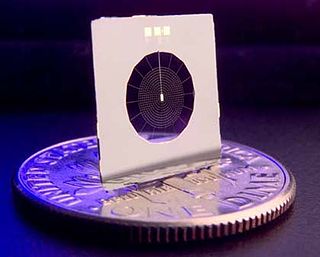Noise-equivalent power (NEP) is a measure of the sensitivity of a photodetector or detector system. It is defined as the signal power that gives a signal-to-noise ratio of one in a one hertz output bandwidth. An output bandwidth of one hertz is equivalent to half a second of integration time. The units of NEP are watts per square root hertz. The NEP is equal to the noise spectral density divided by the responsivity. The fundamental equation is .

Shot noise or Poisson noise is a type of noise which can be modeled by a Poisson process.
Specific detectivity, or D*, for a photodetector is a figure of merit used to characterize performance, equal to the reciprocal of noise-equivalent power (NEP), normalized per square root of the sensor's area and frequency bandwidth.

A calorimeter is an object used for calorimetry, or the process of measuring the heat of chemical reactions or physical changes as well as heat capacity. Differential scanning calorimeters, isothermal micro calorimeters, titration calorimeters and accelerated rate calorimeters are among the most common types. A simple calorimeter just consists of a thermometer attached to a metal container full of water suspended above a combustion chamber. It is one of the measurement devices used in the study of thermodynamics, chemistry, and biochemistry.
The thermal conductivity of a material is a measure of its ability to conduct heat. It is commonly denoted by , , or .

In physics, a phonon is a collective excitation in a periodic, elastic arrangement of atoms or molecules in condensed matter, specifically in solids and some liquids. A type of quasiparticle, a phonon is an excited state in the quantum mechanical quantization of the modes of vibrations for elastic structures of interacting particles. Phonons can be thought of as quantized sound waves, similar to photons as quantized light waves.

A bolometer is a device for measuring radiant heat by means of a material having a temperature-dependent electrical resistance. It was invented in 1878 by the American astronomer Samuel Pierpont Langley.

Johnson–Nyquist noise is the electronic noise generated by the thermal agitation of the charge carriers inside an electrical conductor at equilibrium, which happens regardless of any applied voltage. Thermal noise is present in all electrical circuits, and in sensitive electronic equipment can drown out weak signals, and can be the limiting factor on sensitivity of electrical measuring instruments. Thermal noise increases with temperature. Some sensitive electronic equipment such as radio telescope receivers are cooled to cryogenic temperatures to reduce thermal noise in their circuits. The generic, statistical physical derivation of this noise is called the fluctuation-dissipation theorem, where generalized impedance or generalized susceptibility is used to characterize the medium.
The fluctuation–dissipation theorem (FDT) or fluctuation–dissipation relation (FDR) is a powerful tool in statistical physics for predicting the behavior of systems that obey detailed balance. Given that a system obeys detailed balance, the theorem is a proof that thermodynamic fluctuations in a physical variable predict the response quantified by the admittance or impedance of the same physical variable, and vice versa. The fluctuation–dissipation theorem applies both to classical and quantum mechanical systems.

Gaussian noise, named after Carl Friedrich Gauss, is a term from signal processing theory denoting a kind of signal noise that has a probability density function (pdf) equal to that of the normal distribution. In other words, the values that the noise can take are Gaussian-distributed.
A microbolometer is a specific type of bolometer used as a detector in a thermal camera. Infrared radiation with wavelengths between 7.5–14 μm strikes the detector material, heating it, and thus changing its electrical resistance. This resistance change is measured and processed into temperatures which can be used to create an image. Unlike other types of infrared detecting equipment, microbolometers do not require cooling.

Hg1−xCdxTe or mercury cadmium telluride is a chemical compound of cadmium telluride (CdTe) and mercury telluride (HgTe) with a tunable bandgap spanning the shortwave infrared to the very long wave infrared regions. The amount of cadmium (Cd) in the alloy can be chosen so as to tune the optical absorption of the material to the desired infrared wavelength. CdTe is a semiconductor with a bandgap of approximately 1.5 electronvolts (eV) at room temperature. HgTe is a semimetal, which means that its bandgap energy is zero. Mixing these two substances allows one to obtain any bandgap between 0 and 1.5 eV.
Quantum noise is noise arising from the indeterminate state of matter in accordance with fundamental principles of quantum mechanics, specifically the uncertainty principle and via zero-point energy fluctuations. Quantum noise is due to the apparently discrete nature of the small quantum constituents such as electrons, as well as the discrete nature of quantum effects, such as photocurrents.
In statistics, the Fano factor, like the coefficient of variation, is a measure of the dispersion of a probability distribution of a Fano noise. It is named after Ugo Fano, an Italian American physicist.
Cryogenic particle detectors operate at very low temperature, typically only a few degrees above absolute zero. These sensors interact with an energetic elementary particle and deliver a signal that can be related to the type of particle and the nature of the interaction. While many types of particle detectors might be operated with improved performance at cryogenic temperatures, this term generally refers to types that take advantage of special effects or properties occurring only at low temperature.

In electronics, noise is an unwanted disturbance in an electrical signal.

A transition-edge sensor (TES) is a type of cryogenic energy sensor or cryogenic particle detector that exploits the strongly temperature-dependent resistance of the superconducting phase transition.

In statistical mechanics, thermal fluctuations are random deviations of a system from its average state, that occur in a system at equilibrium. All thermal fluctuations become larger and more frequent as the temperature increases, and likewise they decrease as temperature approaches absolute zero.

Alexander A. Balandin is an electrical engineer, solid-state physicist, and materials scientist best known for the experimental discovery of unique thermal properties of graphene and their theoretical explanation; studies of phonons in nanostructures and low-dimensional materials, which led to the development of the field of phonon engineering; investigation of low-frequency electronic noise in materials and devices; and demonstration of the first charge-density-wave quantum devices operating at room temperature.
In electronics, electrothermal feedback is the interaction of the electric current and the temperature in a device with a temperature-dependent electrical resistance. This interaction arises from Joule heating.

















